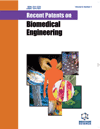- Home
- A-Z Publications
- Recent Patents on Biomedical Engineering (Discontinued)
- Previous Issues
- Volume 1, Issue 3, 2008
Recent Patents on Biomedical Engineering (Discontinued) - Volume 1, Issue 3, 2008
Volume 1, Issue 3, 2008
-
-
Preterm Birth Analysis Using Nonlinear Methods
More LessAuthors: Tijana Ivancevic, Lakhmi Jain, John Pattison and Alex HarizIn this paper, we review modern nonlinearity methods that can be used in preterm birth analysis. The nonlinear analysis of uterine contraction signals can provide information regarding physiological changes during the menstrual cycle and pregnancy. This information can be used both for preterm birth prediction and preterm labour control. Both the contractions in different topographic regions of the uterus and the time d Read More
-
-
-
Generation of Universal Red Blood Cells: An Evaluation of Various Approaches
More LessAuthors: Parimala Nacharaju and Seetharama A. AcharyaThere has been a continuous effort for more than two decades to generate universal red blood cells that can be used for transfusion without the need of matching the blood type. Three distinct strategies are being explored so far to achieve this goal. These include (i) deletion of the antigenic determinants of the blood group antigens on the surface of RBC by enzymatic methods, (ii) masking of the antigens from the cognate a Read More
-
-
-
Enhanced Nitinol Properties for Biomedical Applications
More LessAuthors: Andrea Biscarini, Giovanni Mazzolai and Ausonio TuissiIn recent years, Nitinol producers and medical products have experienced an exponential growth, driven by advanced manufacturing techniques and the use of progressively less invasive medical procedures. Concurrently, new processing techniques have been developed to further enhance the valuable properties of Nitinol used in medical devices; recent patents on these techniques include changing the composition of nickel Read More
-
-
-
Recent Advances and Patents on Novel Devices for Minimally Invasive Treatment of Functional Mitral Regurgitation
More LessAuthors: Jacquelyn Catanese, Tomohiro Anzai and Kiyotaka FukamachiThere are a variety of novel patented devices available to treat functional mitral regurgitation. Aside from direct valve replacement or repair, devices that can be implanted through a minimally invasive approach tend to amend this disease via one of three techniques: edge-to-edge repair, annuloplasty, or left ventricular reshaping. Recent attention has been allocated towards development of prospective devices to enable p Read More
-
-
-
MR Imaged Polymer Gel Radiation Dosimetry: Disclosed Yet Unpatented
More LessAuthors: Panagiotis E. Antoniou and Eleni KaldoudiThe advent of complex radiotherapy techniques has created new challenges for radiation dosimetry. Intensity modulated, stereotactic, conformal radiotherapy, radiosurgery and brachytherapy present a field where both spatial and quantitative accuracy become crucial to the success of the treatment. Methods for true 3-D dosimetry are mostly based on various forms of chemical dosimetry such as Fricke dosimetry and the r Read More
-
-
-
Recent Progress on the Development of Porous Bioactive Calcium Phosphate for Biomedical Applications
More LessAuthors: Toibah Abdurrahim and Iis SopyanHydroxyapatite (HA) and tricalcium phosphate are two members of the calcium phosphate compounds which have been used clinically for many years. Their good biocompatibility is attributed by its similar chemical composition to that of bone material. Porous calcium phosphate ceramics have found enormous use in biomedical applications including bone tissue regeneration, cell proliferation, and drug delivery. In bone tiss Read More
-
Most Read This Month
Article
content/journals/biomeng
Journal
10
5
false
en


